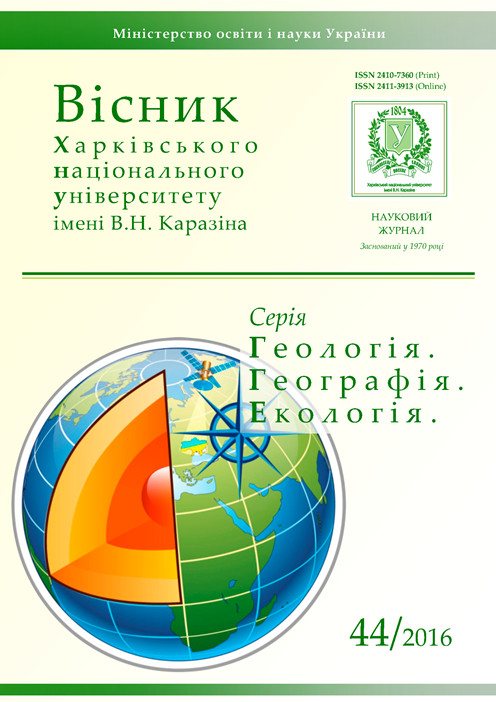Raising reservoir pressure in the gas condensate deposit as a factor of its development efficiency increase
Abstract
Raising the initial reservoir pressure in the gas-condensate deposits has never been carried out hitherto - neither in Ukraine, nor in the world. At first glance, it can be considered an absurd phenomenon and loss of marketable gas or another reagent that should be pumped into the reservoir prior to the development of the field. However, it should be noted that raising the reservoir pressure in the exhaust gas condensate deposits occurs in the formation and operation of the underground gas storage facilities. This technology of gas injection into the reservoir has been worked out on thirteen underground gas storage facilities in Ukraine and in the fields, which were developed in the mode of cycling processes: Novotroitsk, Tymofiivka, Kotolevsk and Kulychihinsk.
Now a question arises how the raising of reservoir pressure in the gas condensate deposit may affect the efficiency of its development? According to the authors, two areas of efficiency can be selected: the first (geological) - specification of gas and condensate reserves; the second – augmentation of condensate production in the cycling process by raising the reservoir pressure in the deposit prior to its development.
As to the first direction, there are several ways to determine the reserves of natural gas in gas-condensate beds and deposits. There are two main methods to calculate gas reserves : 1) volume method of calculating gas reserves; 2) calculation of gas reserves by pressure drop in the reservoir. Each of these methods has its advantages and disadvantages.
Volumetric method allows to estimate gas reserves at the early stages of exploration and development of beds and deposits, and its accuracy mainly depends on the number of drilled wells and the adequately determined calculation parameters, gas content area, efficient gas-saturated thickness, porosity, gas saturation, reservoir pressure.
Calculation method of gas reserves by reservoir pressure drop is possible after the extraction of some amount of gas from the deposits and its reliability is higher, the bigger this amount is. With this only some amount of drained gas is determined.
In this paper the possibility to evaluate gas reserves prior to their development by raising reservoir pressure by injecting foreign gas, has been shown. In fact, this is the use of reverse algorithm method of estimating gas reserves on reservoir pressure fall.
As for the other direction – it is a pioneer method and has never been used in practice.
Downloads
References
2. Fik, І. M. (1997). Proektnі rіshennja z novimi tehnologіjami na Kulichihіns'komu naftogazo–kondensatnomu rodovishhі j Naftova і gazova promislovіst', 5, 25–27.
3. Fik, І.M. (1998). Novі modifіkacії sajklіng–procesu. Mater. 5–і Mіzhnar. konf. UNGA «Nafta–Gaz Ukraїni 98», 2, Poltava, 83–84.
4. Chornij, O.M. (2009). Metod vidobuvannja zashheplenogo і rozchinenogo gazu z pіdvishhennjam tisku gazu a stvolі sverdlovini. «Naftogazova geofіzika – stan і perspektivi» mіzhnarodna naukovo-praktichna konferencіja (Іvano–Frankіvsk, 25–29 travnja 2009). Іvano– Frankіvs'k, 273–275.
5. Chornij, M.І., Chornij, O.M., Metoshop, І.M., Kuzіv, І.M. (2013). Geologіchnі osnovi rozkrittja і viprobuvannja produktivnih plastіv. Іvano–Frankіvs'k, 306.
6. Grishanenko V.P., Zarubіn Ju.O., Doroshenko V.M. ta іnshі. (2014). Naukovі osnovi vdoskonalennja sistem rozrobki rodovishh nafti і gazu. Kiїv, 454.
7. Dovіdnik z naftogazovoї spravi (1996). Za zagal'noju redakcіeju V.S. Bojko, R.M. Konurata, R.S. Jaremіjchuka, UFDTUNG, L'vіv.
8. Ermolov, O.M., Remizov, V.V., Shirkovskij, L.I., Chugunov, L.S. (1996). Fizika plasta i podzemnoe hranenie gaza. M.: Nauka, 541.
9. Іvanіshin, V.S. (2003). Naftogazopromislova geologіja. Pіdruchnik. L'vіv, 648.
10. Orlov, O.O., Fik, І.M., Bondarchuk, V.S., Mazur, A.P. (2015). Bіtumonaftogazogeologіchne rajonuvannja, naftovі і gazovі rodovishha ta pіdzemnі shovishha gazu Ukraїni. Monografіja. Za red. O.O. Orlova. Іvano–Frankіvs'k: Simfonіja forte, 540.
11. Stepanova, G.S. (1983). Fazovye prevrashhenija v mestorozhdenijah nefti i gaza. Moskva: Nedra, 104–116.
12. Savkіv, B.P., Pіnchuk, S.O. (2013). Stvorennja ta ekspluatacіja pіdzemnih shovishh gazu. Kiyv, «Svіt uspіhu», 315.
13. Zhdanov, M.A. (1970). Neftepromyslovaja geologija i podschet zapasov nefti i gaza. Moskva: Nedra, 486.
14. Korbanova, V. N. (1986). Petrofizika. Uchebnik dlja vuzov. M.: Nedra, 392.
15. Fik, M.I., Gorelik S.I., Raєvs'kij Ja.A. (2015). Petrofizika neftegazovyh kollektorov i fljuidouporov. Uchebnik. Har'kov: Folio, 222.
16. Fyk M.I. (2015). Osnovy razrabotki i jekspluatacii neftjanyh i gazovih mestorozhdenij. Uchebnoe posobie. Har'kov, 251.
17. Instrukcija po kompleksnomu issledovaniju gazovyh i gazokondensatnyh plastov i skvazhin (1980). M: Nedra, 301.
18. Soldatkov, S.G., Marushenko, I.V., Voronov, S.A. (2010). Jenergosberegajushhie tehnologii utilizacii plastovih poter gaza pri jekspluatacii PHG. Gazovaja promyshlennost', 9, 63–65.
19. Snarskij, A.N. (1961). Geologicheskie osnovy fiziki plasta. Kiev: Gos. izd-vo tehn. lit. USSR, 248.
20. Fyk I.M. (1982). Podschet promyshlennyh zapasov gaza ob"emnym metodom pri aktivnom vodonapornom rezhime. JeI VNIIgazprom. Ser. Geologija, burenie i razrabotka gazovyh m-j, 13, 8–12.





